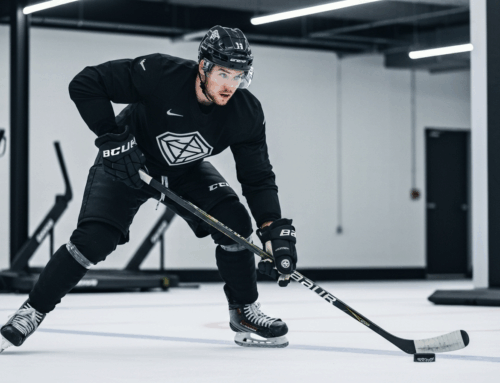Maximize Hockey Skills: Skating Treadmill Benefits for Hockey
Elevating Your Game: The Demand for Data-Driven Hockey Training
In the high-speed world of hockey, success hinges on more than just raw talent; it requires precision, consistency, and continuous improvement. Modern players and coaches are constantly seeking innovative methods to gain a competitive edge, and traditional training approaches are evolving to meet this demand. The push for data-driven insights and controlled environments has brought advanced tools to the forefront of player development. Among these, the integration of specialized equipment like the skating treadmill offers significant skating treadmill benefits for hockey players looking to refine their technique and boost their on-ice performance.
Revolutionizing Skates: Unpacking the Skating Treadmill Benefits for Hockey Development
The skating treadmill stands as a revolutionary tool in hockey training, offering a unique, controlled environment for players to hone their skating mechanics. Unlike traditional ice sessions, the treadmill provides a consistent surface and adjustable speeds and inclines, allowing athletes to isolate and perfect specific elements of their stride. The controlled setting minimizes distractions, enabling a focused approach to skill acquisition. One of the primary skating treadmill benefits for hockey players is the ability to achieve high repetitions of correct movements, building muscle memory that translates directly to efficiency on the ice. To explore the nuances of skating treadmill training, you can read more about the pros and cons of skating on a treadmill for hockey players.
These specialized treadmills are designed to replicate the feel of ice, allowing for full range of motion in the skating stride. This makes them ideal for:
- Developing powerful leg drive and extension.
- Improving hip and knee flexion for optimal stride recovery.
- Enhancing balance and stability on the edges.
- Building anaerobic and aerobic endurance specific to skating.
Mastering Mechanics: How Treadmills Enhance Stride and Edge Work
Precision in skating mechanics is paramount for any hockey player. The skating treadmill provides an unparalleled platform for dissecting and perfecting every component of a player’s stride. Coaches can observe athletes from multiple angles, identifying subtle inefficiencies or compensatory movements that might go unnoticed on a chaotic ice surface. This close observation, combined with the ability to adjust speed and resistance, allows for targeted adjustments to improve push-off, glide, and recovery.
Edge work, critical for agility and quick directional changes, can be meticulously practiced on a skating treadmill. Players can work on deep edge control, crossovers, and tight turns without the risk of falling or the need to constantly reset. The consistent surface allows for endless repetitions, ingraining proper technique and strengthening the specific muscle groups responsible for intricate movements. This focused attention on fundamental mechanics is one of the most significant skating treadmill benefits for hockey players striving for elite-level agility and power.
Beyond Raw Speed: Leveraging Performance Data from Treadmill Sessions
While often associated with building speed, the true power of skating treadmills extends to the rich performance data they can generate. Modern treadmills are often equipped with sensors and analytics software that capture a wealth of information, from stride length and frequency to power output and symmetry. This objective data moves training beyond subjective observation, providing players and coaches with actionable insights.
For instance, data on left-to-right leg power distribution can highlight muscular imbalances, allowing for targeted off-ice strengthening. Consistent monitoring of stride length and frequency at different speeds can reveal plateaus or improvements in efficiency. This data-driven approach ensures that training is optimized and progress is measurable. Understanding the power of personalized hockey performance analytics can further illustrate how this data is used to tailor training regimens for maximum impact.
Key metrics often tracked include:
- Stride Power: Force generated with each push.
- Stride Length & Frequency: How long and how often each stride is taken.
- Balance & Symmetry: Distribution of weight and power between legs.
- Heart Rate & Caloric Burn: Physiological responses to training intensity.
This granular data empowers players to train smarter, identifying specific areas for improvement and tracking their progress with precision.
Instant Replay, Instant Improvement: Video Analysis on the Skating Treadmill
One of the most immediate and impactful skating treadmill benefits for hockey training is the integration of real-time video analysis. With cameras positioned around the treadmill, players can see their skating form instantly, allowing them to compare their movements against ideal mechanics or their own previous attempts. This visual feedback is invaluable for kinesthetic learners and accelerates the correction process.
Coaches can use slow-motion playback to pinpoint specific flaws, such as improper knee bend, hip rotation, or ankle flexion. Players can then make immediate adjustments and see the results in real-time, fostering a deeper understanding of their body’s mechanics. This iterative process of watch, learn, adjust, and improve is significantly more efficient than traditional on-ice video sessions, where players might have to wait hours or days for feedback. The immediacy of the feedback loop makes the skating treadmill an incredibly powerful diagnostic and corrective tool.
Personalized Pathways: Building Baselines and Tracking Progress
Every hockey player is unique, with distinct strengths and areas for development. The skating treadmill excels in providing a personalized training environment. By establishing a baseline performance at the outset, coaches can identify a player’s starting point across various metrics. From there, customized training plans can be developed, focusing on specific weaknesses or building upon existing strengths.
Regular sessions on the treadmill allow for consistent tracking of progress against these baselines. This long-term data collection helps visualize development trends, celebrate achievements, and adjust training intensity as needed. Whether the goal is to increase top-end speed, improve endurance, or refine a specific aspect of the stride, the treadmill provides a controlled and measurable environment to achieve these objectives. This personalized approach ensures that every training minute is productive and directly contributes to the player’s overall development. Players can also master specific skating treadmill drills to further refine their skills.
Integrating Treadmill Training for Competitive Advantage
The myriad of skating treadmill benefits for hockey players makes it an indispensable component of a comprehensive training program. While it doesn’t replace on-ice practice, it significantly enhances it by providing a focused environment for skill refinement, physical conditioning, and data-driven insights. Integrating treadmill sessions into a player’s routine can lead to:
- Increased on-ice speed and acceleration.
- Improved endurance and recovery between shifts.
- More efficient and powerful strides.
- Enhanced agility and edge control.
- Reduced risk of injury through biomechanical correction.
For players and coaches committed to maximizing potential, the skating treadmill offers a competitive advantage that can translate into tangible improvements on the ice. As technology continues to evolve, these specialized training tools will only become more sophisticated, further empowering hockey players to reach new heights in their performance. To delve deeper into whether a skating treadmill is the right investment for your training regimen, it’s beneficial to read expert opinions on its worth.
Have questions? Contact us here.

We use only the finest ingredients to produce stellar tastes.












